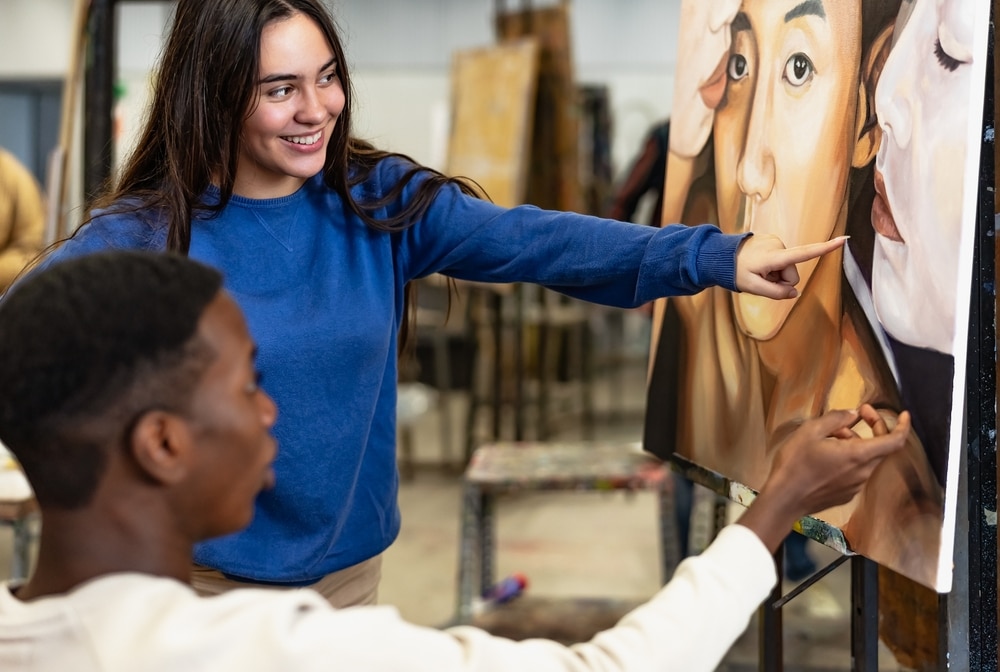Pursuing a BFA Degree: Navigating the Challenges and Embracing the Rewards of the Creative Industries
Creativity is integral to the human experience, shaping our culture, traditions, and collective memory. From the earliest cave paintings to the latest digital masterpieces, art has been a constant source of inspiration and wonder throughout human history. Pursuing a BFA degree allows students to hone their artistic skills and unleash their creativity, producing works of art that have the power to move and inspire others.
Creative fields are about personal expression and aesthetics and have significant economic, social, and cultural impacts. According to the National Endowment for the Arts, the arts and culture sector contributes over $877 billion to the US economy, supporting millions of jobs and driving tourism and community development. Creative industries foster innovation and diversity and promote dialogue and understanding across cultures and perspectives.
In this post, we’ll look at what a BFA degree entails, explore the different career paths available to BFA graduates, and examine the benefits and challenges of pursuing a BFA degree. By the end of this post, you’ll better understand what it takes to succeed in the creative industry and why pursuing a BFA degree is a worthwhile investment in your future.
What is a BFA degree?
What is a BFA degree? The Bachelor of Fine Arts (BFA) degree is a four-year undergraduate program that focuses on developing students’ artistic skills in various mediums, including visual arts, performing arts, and digital media. BFA programs provide a more specialized education than bachelor’s degrees, such as a Bachelor of Arts (BA) or a Bachelor of Science (BS). BFA programs typically include a combination of studio courses, art history classes, and general education courses.
A BFA degree aims to prepare students for careers in the creative industries, such as visual art, design, theater, film, and music. Graduates of BFA programs have a strong foundation in their chosen fields. They have the skills and knowledge to create original works of art and design that are aesthetically pleasing and conceptually engaging.
Curriculum and specializations
BFA programs offer a variety of specializations that allow students to focus on their areas of interest and develop their skills in specific mediums. Specializations can include drawing, painting, sculpture, graphic design, fashion design, theater, music, film, and animation. In addition to specialization courses, BFA programs include general education courses, such as English, mathematics, and social sciences, to provide students with a well-rounded education.
The curriculum of a BFA degree is designed to help students develop their creativity and critical thinking skills through hands-on experience and exposure to art history and theory. BFA programs often include a thesis project, where students create a body of work that demonstrates their skills and vision as artists.
Differences between a BFA and other bachelor’s degrees
The main difference between a BFA degree and other bachelor’s degrees, such as a BA or BS, is the focus on the arts. BFA programs provide more specialized education in the visual and performing arts, while other degrees offer a broader range of courses across multiple disciplines. BFA programs often have a more rigorous curriculum, emphasizing studio work, critiques, and portfolio development.
BFA graduates are typically more focused on pursuing careers in the arts, while graduates of other bachelor’s degrees may have more diverse career options. While BFA programs can be more demanding and require more artistic skill and talent, they also offer students a unique opportunity to develop their creativity and express themselves through their art.
What can you do with a BFA degree?
What can you do with a BFA degree? Career opportunities in various creative fields such as fine arts, graphic design, fashion, and film.
Graduates with a BFA degree have various career opportunities in various creative fields. Fine arts graduates can become professional artists, gallery curators, art educators, or art administrators. Graphic design graduates can work in advertising agencies, marketing departments, or web design firms. Fashion design graduates can pursue fashion design, retail, or merchandising careers. Film and animation graduates can work in the film industry, advertising, or animation studios.
Other potential career paths for BFA graduates include illustration, photography, music, theater, and dance. The creative industries are constantly evolving, and with a BFA degree, graduates are well-positioned to adapt to new opportunities and emerging technologies.
Real-life examples of successful BFA degree holders in different industries
Many successful artists and creatives have pursued a BFA degree and built thriving careers in their respective fields. For example, the renowned artist and filmmaker Julian Schnabel earned a BFA from the University of Houston before becoming a leading figure in the Neo-expressionist movement in the 1980s.
The fashion designer Vera Wang also earned a BFA from the University of Paris before launching her eponymous fashion label. The graphic designer David Carson earned a BFA from San Diego State University before revolutionizing the field of graphic design with his innovative typography and layout designs. These examples demonstrate that a BFA degree can be a stepping stone to a successful career in the arts.
Advantages of pursuing a BFA degree over other degrees
One of the main advantages of pursuing a BFA degree over other degrees is the specialized education it provides. BFA programs are designed to develop the skills and knowledge needed to succeed in creative industries, and they offer a more focused curriculum than other bachelor’s degrees. BFA programs also allow students to build a portfolio of their work, which is essential in many creative fields.
Another advantage of pursuing a BFA degree is the exposure to industry professionals and networking opportunities. BFA programs often have connections with galleries, studios, and industry professionals, which can help graduates launch their careers. Finally, a BFA degree provides graduates with transferable skills such as critical thinking, problem-solving, and communication skills essential in any career.
How long does it take to get a BFA degree?
How long does it take to get a BFA degree? A BFA degree program typically lasts four years or eight semesters. Students take studio, art history, and general education courses during this time. The curriculum is designed to provide students with a well-rounded education in the arts while also allowing them to specialize in their chosen field. BFA programs often require a thesis project, where students create a body of work that demonstrates their skills and vision as artists.
Factors that can affect the length of the program
Several factors can affect the length of a BFA degree program. For example, some BFA programs may require more studio hours or offer fewer elective courses, which can extend the length of the program. Other factors that can affect the length of the program include:
- The availability of courses.
- The student’s pace of learning.
- Any breaks or interruptions in the student’s academic career.
Additionally, students who choose to study abroad or participate in internships or co-op programs may take longer to complete their degree.
The duration of a BFA degree is similar to other bachelor’s degrees, such as a Bachelor of Arts (BA) or a Bachelor of Science (BS), which also typically take four years to complete. However, the focus and curriculum of a BFA degree differ from those of other bachelor’s degrees. For example, a BA degree may offer a broader range of courses across multiple disciplines, while a BFA degree provides a more specialized education in the visual and performing arts.
A BS degree may focus on more technical or scientific subjects, such as engineering or computer science. Ultimately, the duration of a degree program is not as important as the quality of education and the skills and knowledge gained during the program.
Benefits of Pursuing a BFA Degree
Acquisition of technical and creative skills
One of the primary benefits of pursuing a BFA degree is acquiring technical and creative skills essential in the creative industries. BFA programs offer hands-on experience in various mediums, such as drawing, painting, sculpture, graphic design, and digital media.
Through a combination of studio courses and critiques, students learn the techniques and processes needed to create original works of art and design. They also develop an understanding of the elements and principles of design, such as color theory, composition, and aesthetics, which are critical in producing visually compelling and conceptually engaging art.
Development of critical thinking and problem-solving abilities
In addition to technical and creative skills, BFA degree programs also provide students with opportunities to develop critical thinking and problem-solving abilities. Students learn to analyze and interpret art and design within social, cultural, and historical contexts through exposure to art history, theory, and criticism. They also learn to evaluate their work and the work of others and use feedback to refine their skills and ideas.
BFA programs also encourage experimentation and risk-taking, which fosters a culture of innovation and creativity.
Opportunities for personal and artistic growth
Another benefit of pursuing a BFA degree is the opportunities for personal and artistic growth. BFA programs provide a supportive and collaborative environment that encourages students to explore their interests and passions.
Students are exposed to different mediums, techniques, and styles, which allows them to develop their artistic voice and vision. BFA programs also offer opportunities for cultural exchange and exposure to diverse perspectives, which broadens students’ horizons and enhances their creativity.
Building a strong portfolio and network of contacts
Finally, pursuing a BFA degree allows students to build a strong portfolio and network of contacts to help launch their careers. BFA programs often provide opportunities to exhibit students’ work in galleries and public spaces, which allows them to showcase their skills and build a body of work.
BFA programs also connect students with industry professionals, alumni, and other creatives, providing students with networking opportunities and exposure to potential employers. These connections can be invaluable in helping graduates land their first jobs or establish themselves as artists and designers.
Pursuing a BFA degree is a worthwhile investment in personal and professional development. Whether you aspire to become a professional artist, designer, or creative professional, a BFA degree can provide the skills, knowledge, and experiences needed to succeed in today’s dynamic and exciting creative industries.
Challenges of Pursuing a BFA Degree
The high level of competition in creative industries
One of the main challenges of pursuing a BFA degree is the high level of competition in creative industries. The creative arts attract many talented individuals, and the competition for jobs and commissions can be fierce. Graduates must be prepared to work hard and persist in pursuing their careers. They may need internships or entry-level positions to gain experience and build portfolios.
Additionally, graduates must be willing to market themselves and their work, network with industry professionals, and stay up-to-date with emerging trends and technologies.
The need for self-motivation and self-discipline
Another challenge of pursuing a BFA degree is the need for self-motivation and self-discipline. BFA programs are demanding and require students to be self-driven and committed to their craft.
Students must be willing to put in long hours in the studio, work independently on their projects, and meet deadlines. They must also be open to constructive criticism and feedback and be willing to revise their work accordingly.
Financial challenges, including the cost of supplies and equipment
Finally, pursuing a BFA degree can be financially challenging. BFA programs often require students to purchase their art supplies and equipment, which can be expensive. Students may also need to cover the costs of travel, studio rental, and other expenses associated with creating and exhibiting their work.
Additionally, the cost of tuition for BFA programs can be higher than other bachelor’s degrees, which can add to the financial burden. Students may need to seek out scholarships, grants, or other forms of financial aid to help offset the costs.
Pursuing a BFA degree requires a strong commitment to one’s craft and a willingness to overcome the challenges associated with the creative industry. Graduates must be persistent, self-motivated, and financially savvy to succeed in these dynamic and competitive fields. Despite the challenges, the rewards of pursuing a BFA degree can be immeasurable, providing graduates with the skills, knowledge, and experiences needed to build fulfilling and successful careers in the arts.
Conclusion
In summary, a Bachelor of Fine Arts (BFA) degree provides students with a specialized education in creative arts, offering opportunities to acquire technical and creative skills, develop critical thinking and problem-solving abilities, and foster personal and artistic growth. BFA graduates also have opportunities to build a strong portfolio and network of contacts that can help them launch their careers.
However, pursuing a BFA degree can also present challenges, including high competition in creative industries, the need for self-motivation and self-discipline, and financial challenges associated with the cost of supplies and equipment.
Despite these challenges, pursuing a BFA degree can be a worthwhile investment for those passionate about pursuing careers in the arts. Creative industries play a vital societal role, driving innovation and economic growth.
Pursuing a BFA degree can prepare graduates to succeed in these dynamic and exciting fields, providing them with the skills, knowledge, and experiences needed to make a difference and express their unique artistic vision.
If you’re interested in pursuing a BFA degree, we encourage you to explore the many opportunities available. Research different BFA programs, consider your interests and passions, and seek advice and guidance from industry professionals, alumni, and other creatives. With dedication, hard work, and a willingness to take risks and experiment with new ideas, you can make your mark in the creative industries and create a fulfilling and rewarding career in the arts.
If you’re set on getting into a world-class college but aren’t sure how to make it happen, we can help! AdmissionSight is a leading college entrance expert with over a decade of experience helping students just like you get into the schools of their dreams.
At AdmissionSight, we focus on offering a wide range of services, all aimed at helping students perfect their applications to catch the attention of admissions officers. Contact us today to schedule a free consultation to learn more about what we offer.









































